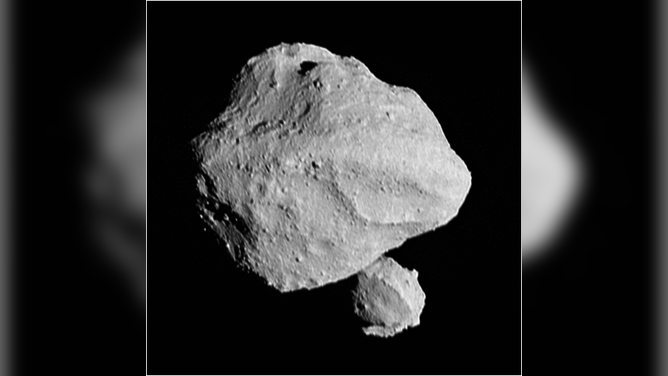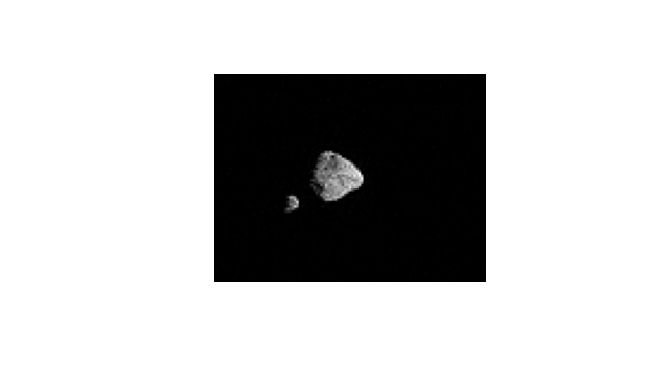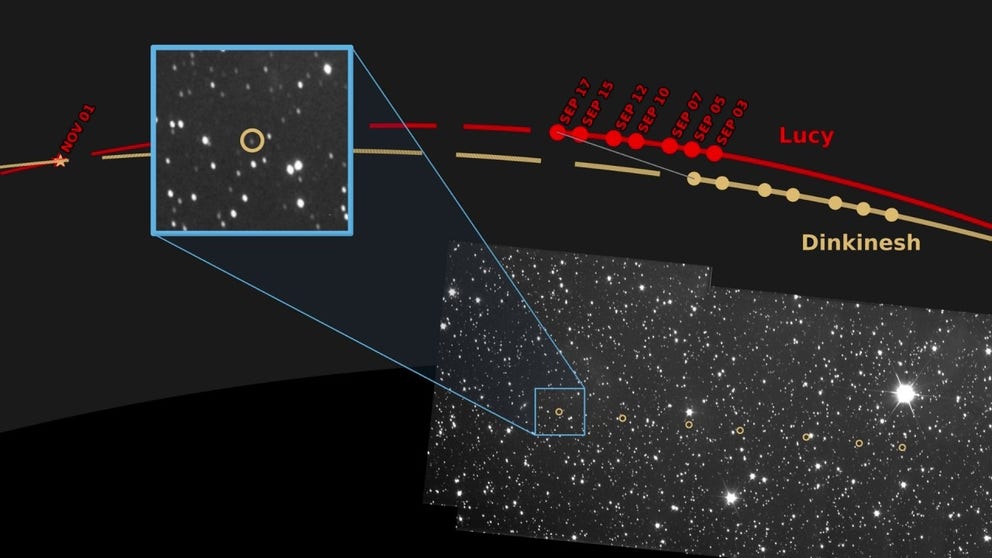NASA's Lucy mission makes 'marvelous' discovery of second asteroid during Dinkinesh flyby
Lucy zoomed by Dinkinesh going 10,000 mph from about 270 miles above the asteroid, using its Long-Range Reconnaissance Imager camera to take one of the most detailed images of the asteroid binary system.
Where is the asteroid Dinkinesh?
An artist visualization overlays images taken by NASA's Lucy spacecraft of the asteroid Dinkinesh. Lucy made a close flyby of the asteroid on Nov. 1.
NASA's Lucy spacecraft made its first flyby of an asteroid on Wednesday, and the mission team found a surprise waiting when the first images arrived back on Earth: another tiny asteroid.
Lucy is en route to explore the Trojan asteroids associated with Jupiter and will eventually fly by 10 different space rocks, but according to mission principal investigator Hal Levison, Lucy's tour count just went up.
When Lucy flew by the asteroid named Dinkinesh, which means "marvelous" in the Amharic language, NASA said the spacecraft's cameras revealed another small asteroid orbiting the bigger asteroid, making it a binary asteroid system.

This image shows the "moonrise" of the satellite as it emerges from behind asteroid Dinkinesh as seen by the Lucy Long-Range Reconnaissance Imager (L’LORRI), one of the most detailed images returned by NASA’s Lucy spacecraft during its flyby of the asteroid binary. This image was taken at 12:55 p.m. EDT (1655 UTC) Nov. 1, 2023, within a minute of closest approach, from a range of approximately 270 miles (430 km). (Image: NASA/Goddard/SwRI/Johns Hopkins APL/NOAO)
(NASA/Goddard/SwRI/Johns Hopkins APL/NOAO)
"Dinkinesh really did live up to its name; this is marvelous," said Levison with the Southwest Research Institute. "When Lucy was originally selected for flight, we planned to fly by seven asteroids. With the addition of Dinkinesh, two Trojan moons, and now this satellite, we’ve turned it up to 11."
NASA FINDS WATER, BUILDING BLOCKS OF LIFE IN LARGEST-EVER ASTEROID SAMPLE
Some might remember another binary asteroid system visited by different NASA spacecraft, Didymos and Dimorphos. NASA's DART mission intentionally rammed into Dimorphos in September 2022 to test an Earth defense plan when we need to deflect a potentially hazardous asteroid headed toward Earth.
Lucy project scientist Keith Noll, with NASA's Goddard Space Flight Center, said in some ways the Dinkinesh binary system looks similar to Didymos and Dimorphos, but there are some "interesting differences" worth investigating.
"We knew this was going to be the smallest main belt asteroid ever seen up close," Knoll said. "The fact that it is two makes it even more exciting."
Lucy zoomed by Dinkinesh, going 10,000 mph from about 270 miles above the asteroid, using its Long-Range Reconnaissance Imager (LORRI) camera to take one of the most detailed images of the asteroid pair.
With the first images, Lucy's team estimates Dinkinesh to be a half-mile wide, and the smaller asteroid is estimated to be about .15 miles.
NASA said this first flyby of many served as an in-flight test of the spacecraft's terminal tracking system. The series of images below were taken 13 seconds apart by Lucy's tracking camera.

A series of images of the binary asteroid pair, Dinkinesh, as seen by the terminal tracking camera on NASA’s Lucy spacecraft during its closest approach on Nov. 1, 2023. The images were taken 13 seconds apart. NASA/Goddard/SwRI/ASU
(NASA/Goddard/SwRI/ASU)
"This is an awesome series of images. They indicate that the terminal tracking system worked as intended, even when the universe presented us with a more difficult target than we expected," said Tom Kennedy, guidance and navigation engineer at Lockheed Martin. "It’s one thing to simulate, test, and practice. It’s another thing entirely to see it actually happen."
Additional data from Lucy's flyby will take about a week to downlink to Earth.
Lucy's next flyby happens in 2025 when the spacecraft approaches the asteroid Donaldjohanson.
